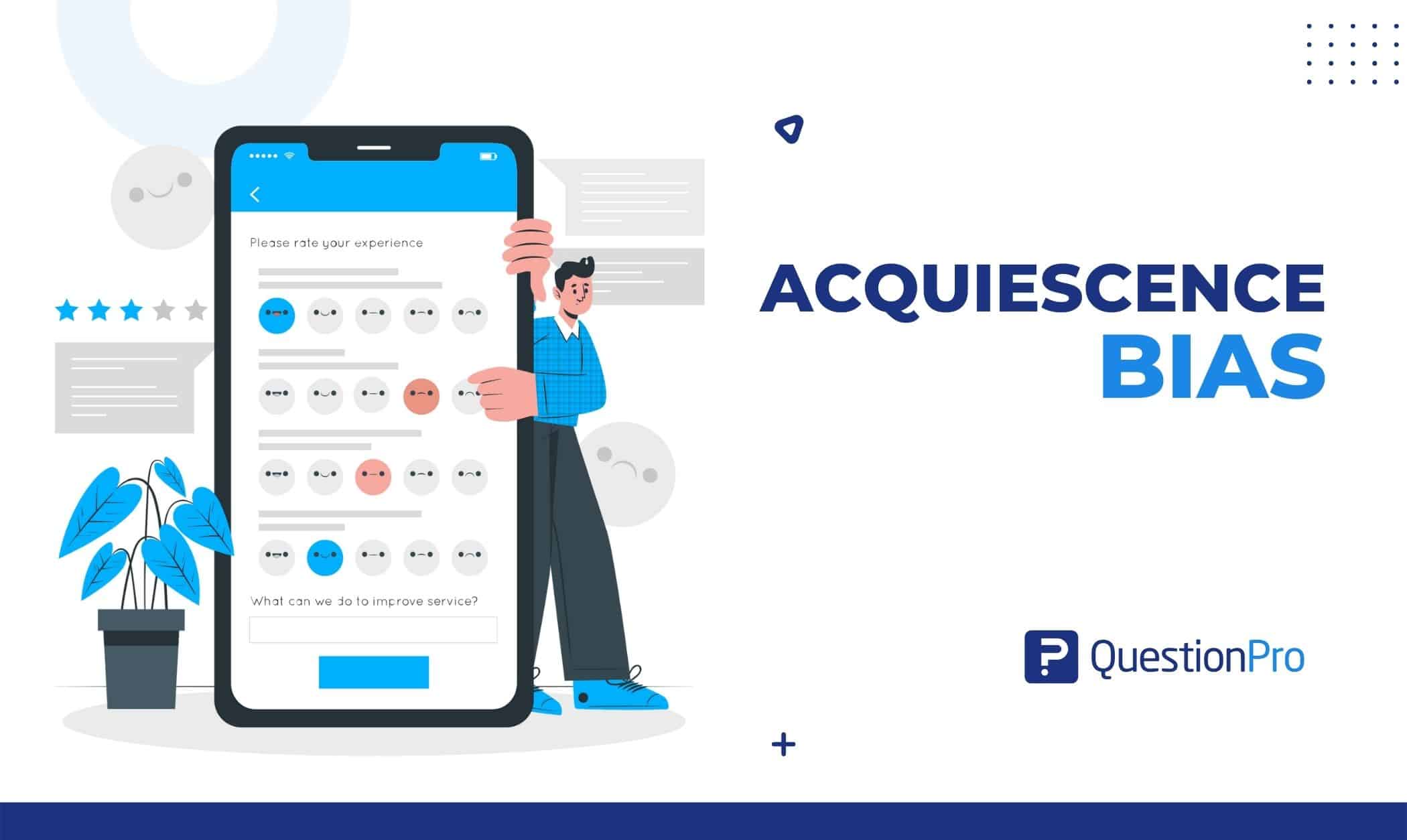
For a good reason, consumer research is frequently concerned with acquiescence bias. A survey respondent who tends to agree with a statement, regardless of their genuine feelings, is said to exhibit acquiescence bias, also known as agreement bias or the “yes” bias.
Sellers, business owners, and marketers who depend on market research to make business decisions may run into issues. It is one of seven notable biases that can distort your survey results and give you a skewed view of the areas of your business that can and should be improved.
In this blog, we’ll examine acquiescence bias in further detail, including what it is, why it happens, and how to avoid it.
What is acquiescence bias?
Acquiescence bias, commonly referred to as agreement bias, is the propensity for survey participants to concur with research findings without doing so in a way that accurately represents their views or the subject at hand.
The problem typically arises when you ask a participant to confirm a statement or if the question is answered in pairs of opposites, such as “Agree/Disagree,” “True/False,” and “Yes/No.” There are undoubtedly many reasons why you agree with this, even if you lack a strong opinion.
For instance, a respondent to a customer satisfaction survey may choose “Very satisfied” because it is the most favorable option and most appealing to the researcher.
Respondents who are tired and start answering questions quickly may also exhibit acquiescence bias. It varies by the various characteristics of respondent groups and is more common in Asian societies than in Western ones.
What leads to acquiescence bias?
Everything in this universe has a reason behind it. So does acquiescence bias. There are various theories among experts as to why acquiescence bias occurs. Some of the major ones are:
- Participants come from a variety of backgrounds.
- Their ideal self has an impact on participants.
- The researcher influences the participants.
- The survey’s respondents aren’t motivated to participate.
- Participants aim to maintain socially acceptable behavior
- Participants disagree that there is a “middle-ground” solution.
Ways to prevent acquiescence bias
The development of every business depends on getting input from customers or clients. Whatever feedback they provide, the information you learn from it should point you in the proper direction. However, bias cannot be avoided.
The tendency for respondents to select the survey alternatives that they find most agreeable is known as acquiescence bias. There are strategies to counteract acquiescence bias in surveys, but not enough people know about them.
Acquiescence bias tends to inflate the positivity of survey results artificially. A “no” response in a survey is crucial as long as you know what you’re doing. Try including some of these suggestions in your surveys to ensure that your respondents are impartial and truthful. Here are some ways to avoid acquiescence bias:
Be brief with your survey.
Survey tiredness is one of the leading causes of acquiescence bias and several other biases. The respondent will want to complete the survey as quickly as possible if it is lengthy and contains challenging questions.
A long, complicated survey will push some people to answer positively just to get through the questions, especially if a reward is offered for completion.
The more worn out your responders become, the less likely they want to think carefully and provide accurate responses. They would just click “yes,” “I agree,” or “extremely satisfied” after that.
This well-known occurrence can severely undermine the efficacy of your survey research, resulting in low survey response rates and partial data. To avoid this, ensure your survey is brief and straightforward while still attempting to collect as much survey data as possible. Suppose you are talking about a website. Questions can be like:
- Does the website have a user-friendly interface?
- Is the website easy to navigate?
- Does the website allow users to use images or videos easily?
- Do you like the website user interface color?
Review your questions.
How you word your survey questions will directly impact how the respondents will answer them. The responders might perceive the language differently.
Acquiescence bias is more likely to be present in questions that may be answered with a simple
- “Yes” or “No” or with
- “Agree” or “Disagree.”
Try to offer a range of options as an alternative so that the respondent can be more explicit in their response.
In contrast to asking the question that the phrase implies, asking a participant how much they agree with a statement is significantly less direct.
Using precise language in your question is preferable in this case.
Acquiescence bias can also be prevented by favoring open-ended questions over multiple-choice ones. The responders will be able to express themselves more clearly by having a free-form response choice than by using simple “Agree/Disagree” options.
Focus your respondent’s attention.
If your responders don’t fully get the question, they may decide to agree without giving it much thought. A similar outcome may result from ambiguous queries.
Participants in your survey shouldn’t find it challenging to complete it. Introduce strategies for them to concentrate on the survey question at hand to assist them. If your questions are too ambiguous, you can add subtitles or retain one question per page. Giving your respondents some assistance can help prevent acquiescence bias in any case.
Select the proper demographic for your respondents.
Beginning with the respondents you wish to participate in your survey, you can avoid prejudices. Due to the variations in backgrounds, recruiting individuals from several nations may exacerbate acquiescence bias. This would also imply that any nationality of each respondent should be able to answer your questions.
Acquiescence bias is less likely to occur if you recruit survey respondents from a particular demographic, especially if the survey is relevant to the participant’s interests.
Make every effort to be impartial.
When conducting a survey, you should play your part as a researcher with tact. In respondents themselves, researchers can introduce bias. The survey’s participants are aware that humans created it.
And what if you surveyed a person? As a result, they are aware that their answers to personal or sensitive inquiries will be scrutinized. Therefore, people could pick the most advantageous and safest alternative rather than give their honest response.
A person’s emotional state may occasionally need to be questioned. It will be easier for respondents to feel free to react honestly and not just to what they think you want to hear if your poll is as neutral as possible.
Be Transparent.
Being honest is the key to overcoming survey fear. Just provide all the information about your survey that the participants require. After all, you ought to be able to notify them if you’re not acting unethically.
- Why was the survey created?
- What are your plans after you have the results?
- How would the survey benefit both the respondent and you?
Respondents will be more motivated to provide accurate information and avoid bias if they are well-informed.
Conclusion
Gaining honest feedback from clients and customers might help you grow your company. Your survey should be successful if you use the appropriate resources and methods. Try to avoid acquiescence response bias in customer surveys using these strategies; the outcomes should speak for themselves.
You can combat acquiescence bias with the help of the many tools and options that QuestionPro offers. To encourage honest answers, you may even make your survey anonymous and inform customers that their identity will be protected from the beginning.
If you want to do your own unbiased, agree or disagree research, use QuestionPro immediately.







